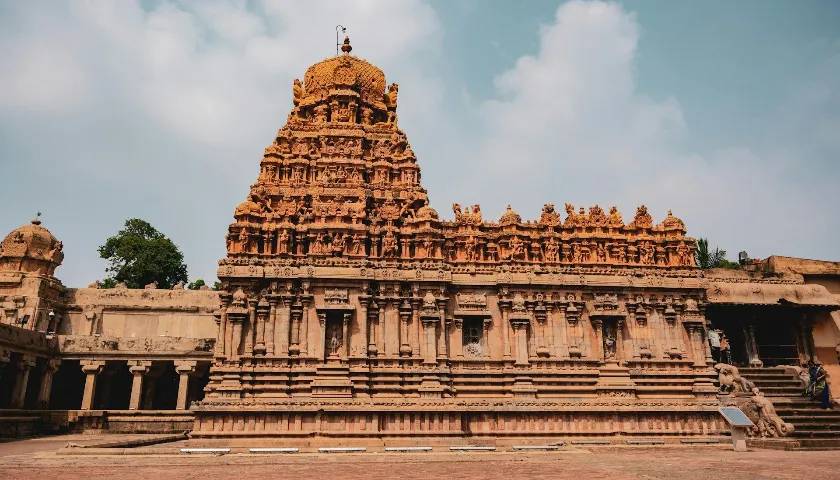The Great Living Chola Temples, located in the Indian state of Tamil Nadu, are a remarkable trio of temples constructed by the Chola dynasty between the 10th and 12th centuries. These temples stand as a testament to the architectural prowess and artistic genius of the Chola period, renowned for their intricate carvings and magnificent sculptures. Recognized as a UNESCO World Heritage Site, these temples continue to captivate visitors with their grandeur and historical significance.
The three temples that comprise this heritage site are the Brihadeeswarar Temple in Thanjavur, the Temple of Gangaikondacholisvaram in Gangaikonda Cholapuram, and the Airavatesvara Temple in Darasuram.
Brihadeeswara Temple, Thanjavur

The Brihadeeswara Temple, often referred to as the Big Temple, is the most prominent and expansive of the three. Commissioned by the Chola king Rajaraja I in the 11th century, this temple is dedicated to Lord Shiva. Its colossal size and elaborate carvings make it a masterpiece of Chola architecture. The temple houses a massive stone lingam, an iconic representation of Shiva, and a gigantic Nandi (Shiva's bull) statue.
One of its most notable features are the 100-pillar hall, and the towering vimana, which stands at 216 feet and is topped by a single 80-tonne granite block. This remarkable feat of engineering was achieved by constructing an inclined plane from a nearby quarry to the top of the temple. The temple's design ensures that the shadow of the vimana never falls on the ground at noon, showcasing the advanced understanding of architecture and astronomy of the Chola engineers.
Temple of Gangaikondacholisvaram, Gangaikonda Cholapuram

Built by Rajaraja I's son, Rajendra I, the Temple of Gangaikondacholisvaram commemorates his victorious campaign against the Pala dynasty. Dedicated to Shiva, the temple is celebrated for its detailed carvings and sculptures, including intricate depictions of the ten avatars of Vishnu. The Golden Lotus Tank, a large water tank within the temple complex, is believed to possess healing properties, adding a layer of mystique to the site.
Airavatesvara Temple, Darasuram

The Airavatesvara Temple, constructed by Rajaraja II in the 12th century, is another stunning example of Chola architecture. This temple, also dedicated to Shiva, is famed for its detailed carvings, including exquisite images of dancers and musicians. One of the unique features of this temple is its musical pillars, which emit different musical notes when struck, reflecting the Cholas' advanced understanding of acoustics and artistry.
Cultural and Social Significance
Under the Chola dynasty, temples became the center of life. They were not just places of worship but also hubs of social, economic, and cultural activities. Temples hosted festivals, housed schools, and served as venues for art and music performances. The Chola kings, revered as gods, were often portrayed in temple sculptures and inscriptions, emphasizing their divine right to rule and their patronage of the arts.
Visiting the Great Living Chola Temples offers a deep dive into the rich history and culture of the Chola dynasty. Each temple, with its own unique architectural and artistic elements, provides a window into the ingenuity and devotion that defined this golden era of Indian history. Exploring these temples is not only a visual delight but also an educational journey into the legacy of one of India’s most illustrious dynasties.
How to Reach the Great Living Chola Temples
By Air: The nearest airport to Thanjavur is Tiruchirappalli International Airport (TRZ), which is about 50 kilometers away. This airport is well-connected to major cities in India and some international destinations. From the airport, you can hire a taxi or take a bus to reach Thanjavur.
By Train: Thanjavur has its own railway station, which is connected to major cities like Chennai, Bangalore, and Madurai. Regular trains operate from these cities to Thanjavur, making it a convenient option for travelers.
By Road: Thanjavur is well-connected by road to various cities in Tamil Nadu and neighboring states. You can take state-run or private buses from Chennai, Bangalore, Madurai, and other major cities. Alternatively, you can hire a taxi or drive your own vehicle to reach Thanjavur.
To fully appreciate the rich history and intricate details of these temples, we suggest booking a guided tour. A knowledgeable guide can provide in-depth information and insights, enhancing your experience. For a personalized and comprehensive tour, contact Alkof Holidays. We can customize your itinerary to match your interests and ensure you have a memorable trip.










